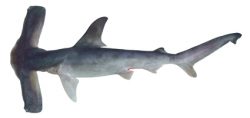select your film:


Winghead Sharks can be found in shallow, tropical waters in the Indo-West Pacific from the Persian Gulf to the Philippines and from China to Australia.
Biology and Behaviour
Winghead sharks are grey or grey-brown above with an off-white underside. They reach a maximum size of 190 cm long. They typically hunt on the sea floor and mainly feed on small teleost fishes, crustaceans and cephalopods.
They have a wing-shaped head which is nearly or quite half of its body length, the function of which is uncertain, maybe for manoeuvring or for increasing the surface area of some the sense organs.
The wide spacing of their eyes allows them to have a good binocular vision which makes them better hunters. Their extremely long nostrils on the leading margin of the cephalofoil may allow for better detection and tracking of door trails in the water. The space between the two nostrils presumably helps them decipher which direction the scent they have picked up.
Their circular eyes, located at the forward outer corners of the cephalofoil, have nictitating membranes. The relatively small, arched mouth contains 15 to 16 upper and 14 lower tooth rows on each side, and sometimes also a single row of tiny teeth and smooth-edged, with angled triangular cusps.
There are five pairs of gill slits, with the fifth pair over the pectoral fin.
Winghead shark’s cephalofoil consists of a pair of long, narrow and gently swept-back blades.
Reproduction and Lifespan
Young winghead sharks are between 32 to 45 cm long at birth and mature around 120 cm in length for females around the age of seven years and 108 cm for males around the age of five years. Compared to other sharks, wingheads are slow growers.
Females are viviparous, where the female gives birth to a live young, and have litters between six to 25 pups every year after gestating for eight to eleven months.
Winghead sharks live up to 21 years.
Conservation and Tourism
They are fished throughout their range, and due to their maximum age, overfishing and the form of their body all make them susceptible to their population depletion.
They were once commonly seen off the coast of India and Indonesia, but today, they are rarely seen. They are highly exploited for their fins and meat.
Winghead sharks are listed as endangered by the IUCN, and there are no conservation measures in place for winghead sharks.
Do you have images or videos of Winghead Sharks?
Submit them to [email protected].
